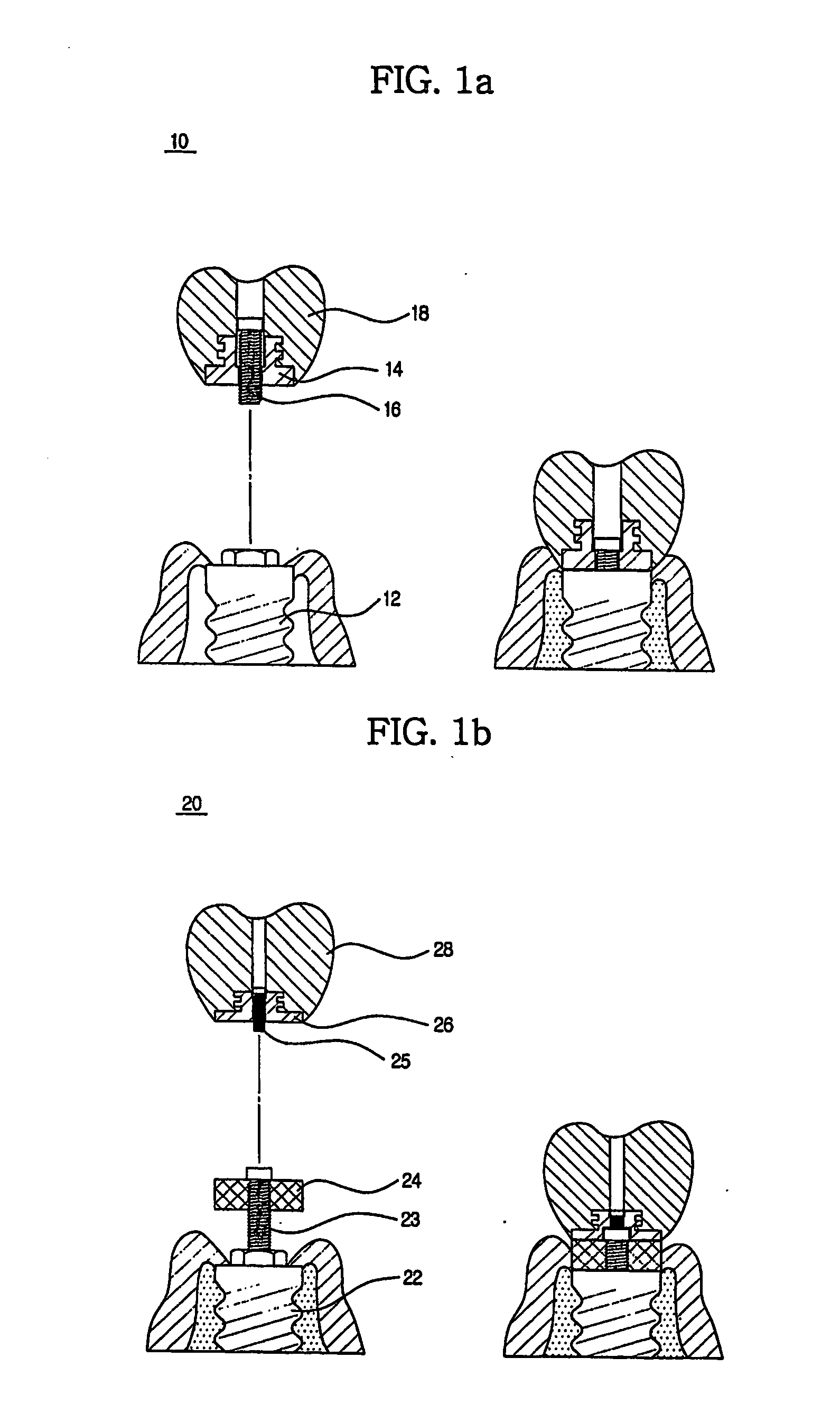Method for treating a screw-cement retained prosthesis, abutment and implant for a screw-cement retained prosthesis
a technology of screw-cement and retained prosthesis, which is applied in the field of dental implants, can solve the problems of difficult repair of the prosthetic appliance, high cost and long time, and difficulty in achieving a precise passive fit, and achieve the effect of precise clinical and laboratory procedures, long time, and high cos
- Summary
- Abstract
- Description
- Claims
- Application Information
AI Technical Summary
Benefits of technology
Problems solved by technology
Method used
Image
Examples
embodiment 1
[0095]FIG. 4 is a sectional view of an SCRP implant according to Embodiment 1 of the present invention, and FIGS. 5a to 5e are sectional views for explaining a method for treating the SCRP implant according to Embodiment 1.
[0096] Referring to FIG. 4, the SCRP implant 100 according to Embodiment 1 comprises a fixture 110, an abutment 120, a screw 140 and a prosthetic appliance 150.
[0097] The fixture 110 comprises the thread 114 formed in its outer surface and is implanted along the thread 114 to the alveolar bone. The thread 114 of the implanted fixture 110 is fused with tissue of the alveolar bone and then is fixed to the alveolar bone. Generally, considerable time is needed for bonding the thread 114 and the alveolar bone to each other.
[0098] A joining groove 112 for receiving a joining projection 130 of the abutment 120 is formed on an upper surface of the fixture 110. The joining groove 112 has a circular inlet, and comprises a sticking groove 116 in a truncated circular conic...
embodiment 2
[0118]FIG. 6 is a sectional view of an SCRP implant according to Embodiment 2 of the present invention, and FIG. 7 is a sectional view for explaining a separating process of the SCRP implant according to Embodiment 2.
[0119] Referring to FIG. 6, the SCRP implant according to Embodiment 2 comprises the fixture 110, an abutment 220, the screw 140 and the prosthetic appliance 150. The fixture 110, screw 140 and prosthetic appliance 150 except the abutment 220 may refer to the explanations and drawings of Embodiment 1, and repetitional contents may be omitted.
[0120] The fixture 110 comprises the joining groove 112 and the thread 114, wherein the joining groove 112 comprises the truncated circular conical sticking groove 116 and the anti-rotating groove 118. A female screw hole corresponding to the screw 140 is formed at the center of the lower end of the anti-rotating groove 118.
[0121] In the same manner as Embodiment 1, the abutment 220 according to the present embodiment comprises a...
embodiment 3
[0129]FIG. 8 is a sectional view of an SCRP implant according to Embodiment 3 of the present invention, and FIG. 9 is a sectional view for explaining a separating process of the SCRP implant according to Embodiment 3.
[0130] Referring to FIG. 8, the SCRP implant according to Embodiment 3 comprises the fixture 110, an abutment 320, the screw 140 and the prosthetic appliance 150. The fixture 110, screw 140 and prosthetic appliance 150 except the abutment 320 may refer to the explanations and drawings of Embodiment 1, and repetitional contents may be omitted.
[0131] The fixture 110 comprises the joining groove 112 and the thread 114, wherein the joining groove 112 comprises the truncated circular conical sticking groove 116 and the anti-rotating groove 118. A female screw hole corresponding to the screw 140 is formed at the center of the lower end of the anti-rotating groove 118.
[0132] In the same manner as Embodiment 1, the abutment 320 according to the present embodiment comprises a...
PUM
 Login to View More
Login to View More Abstract
Description
Claims
Application Information
 Login to View More
Login to View More - R&D
- Intellectual Property
- Life Sciences
- Materials
- Tech Scout
- Unparalleled Data Quality
- Higher Quality Content
- 60% Fewer Hallucinations
Browse by: Latest US Patents, China's latest patents, Technical Efficacy Thesaurus, Application Domain, Technology Topic, Popular Technical Reports.
© 2025 PatSnap. All rights reserved.Legal|Privacy policy|Modern Slavery Act Transparency Statement|Sitemap|About US| Contact US: help@patsnap.com



